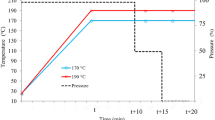Abstract
This paper discusses thickness swell and irreversible thickness swell properties after immersion in water for 24, 48, 96 and 168 h, changes in equilibrium moisture content (EMC) and determination of dimensional changes associated with changes in relative humidity of laboratory-made methylene diphenyl diisocyanate (MDI)-bonded oriented strandboards (OSB). It was observed that thermal post-treatment of said OSB had a positive effect on the above mentioned properties. As far as thickness swell and irreversible thickness swell are concerned, it could be shown that the thermally modified variants generally performed better, i.e. lower values than the respective untreated ones for all four immersion periods and MDI dosages of 3.0, 4.0 und 5.0 %. It was furthermore noticeable that the swelling potential was not exhausted after immersion for 24 h and a prolonged immersion period led to significant increases in respective thickness swelling values. The EMC was decreased and the determination of dimensional changes associated with changes in relative humidity showed that thermally post-treated OSB displayed lower thickness changes when “drying“(from 65 to 30 % relative humidity; RH) as well as when “moistening“(from 65 to 85 % RH) than the untreated controls. For all of the above mentioned properties it can be concluded that the influence of the post-treatment temperature proved to be greater than the reduction of the hydrophobing agent from 1.0 to 0 %.






Similar content being viewed by others
References
Bächle F, Niemz P (2007a) Deutlich geringere Quellwerte bei Thermoholz. Untersuchungen zu ausgewählten Eigenschaften von im Autoklav industriell thermisch vergütetem Laubholz—part 1. Holz-Zentralblatt 133:622–623
Bächle F, Niemz P (2007b) Deutlich geringere Quellwerte bei Thermoholz. Untersuchungen zu ausgewählten Eigenschaften von im Autoklav industriell thermisch vergütetem Nadelholz—part 2. Holz-Zentralblatt 133:759–760
Bekhta P, Niemz P (2003) Effect of high temperature on the change in color, dimensional stability and mechanical properties of spruce wood. Holzforschung 57:539–546
Bonigut J, Krug D (2011) Properties of thermally modified oriented strandboards (OSB). In: Proceedings forest products society 65th international convention, Portland, 19–21 June 2011
Bonigut J, Stephani S, Dube H (2010a) Eigenschaften thermisch vergüteter Massivholzplatten und OSB—part 1: Kurzzeiteigenschaften. Holztechnologie 51(4):14–18
Bonigut J, Stephani S, Dube H (2010b) Eigenschaften thermisch vergüteter Massivholzplatten und OSB—part 2: Langzeiteigenschaften. Holztechnologie 51(5):16–20
Burmester A (1975) Zur Dimensionsstabilisierung von Holz. Holz Roh-Werkst 33:333–335
Chaouch M, Dumarcay S, Petrissans A, Petrissans M, Gerardin P (2013) Effect of heat treatment intensity on some conferred properties of different European softwood and hardwood species. Wood Sci Technol 47:663–673
Del Menezzi CHS, Tomaselli I (2006) Contact thermal post-treatment of oriented strandboard to improve dimensional stability: a preliminary study. Holz Roh-Werkst 64:212–217
Del Menezzi CHS, Tomaselli I, Okino EYA, Teixeira DE, Santana MAE (2009) Thermal modification of consolidated oriented strandboards: effects on dimensional stability, mechanical properties, chemical composition and surface color. Holz Roh- Werkst 67:383–396
EN 322 (1993) Wood-based panels—determination of moisture content
Ernst K (1967) Möglichkeiten zur Verminderung der Quellung bei Spanplatten. Holztechnologie 8:41–47
Fengel D (1966) Über die Veränderungen des Holzes und seiner Komponenten im Temperaturbereich bis 200 °C—Erste Mitteilung: heiß- und Kaltwasserextrakte von thermisch behandeltem Fichtenholz. Holz Roh-Werkst 24:9–14
Fengel D, Przyklenk M (1970) Über die Veränderung des Holzes und seiner Komponenten im Temperaturbereich bis 200 °C—Fünfte Mitteilung: einfluß einer Wärmebehandlung auf das Lignin in Fichtenholz. Holz Roh-Werkst 28:254–263
Heebink BG (1967) Wax in particleboards. In: Proceedings first Washington state university international symposium on particleboard, 1–3 March 1967, Pullman, USA
Krug D (2010) Influence of defibration conditions and resin on the properties of medium density fibreboards (MDF) for use in humid and exterior conditions. PhD thesis, University of Hamburg, Germany
Maloney TM (1993) Modern particleboard & dry-process fiberboard manufacturing. Updated edition, San Francisco, USA, pp 389–405
Mühlböck K, Fillafer F (2001) Verfahren und Vorrichtung zur thermischen Behandlung von Holz. Patent application EP 1 118 828 (A1)
Navi P, Girardet F (2000) Effects of thermo-hydro-mechanical treatment on the structure and properties of wood. Holzforschung 54:287–293
Ohlmeyer M, Paul W (2010) Optimierung der Eigenschaften von Holzwerkstoffen mit Hilfe von thermischen Modifizierungsmethoden. Work report from the Institute of wood technology and wood biology, University of Hamburg, Germany, no 2010/2
Popescu M-C, Lisa G, Froideveaux J, Navi P, Popescu C-M (2014) Evaluation of the thermal stability and set recovery of thermo-hydro-mechanically treated lime (Tilia cordata) wood. Wood Sci Technol 48:85–97
Sandermann W, Augustin H (1963) Chemische Unterschungen über die thermische Zersetzung von Holz: erste Mitteilung: Stand der Forschung. Holz Roh-Werkst 21:256–265
Scheiding W (2011) Verfahren zur thermischen Modifizierung oder Vergütung von Holz und Holzprodukten. Patent application DE102009047137 (A1)
Scheiding W, Flade P, Plaschkies K (2012) Sandwich stacking—a smart innovation for thermal modification in open kilns. In: Proceedings sixth european conference on wood modification, Ljubljana, Slovenia, 16–18 September 2012
Skyba O (2008) Durability and physical properties of thermo-hygro-mechanically (THM)-densified wood. Dissertation thesis, ETH Zurich
Stamm AJ (1956) Thermal degradation of wood and cellulose. Ind Eng Chem 48(3):413–417
Stuckenberg P (2013) Untersuchungen zum Verhalten eines pMDI-Klebstoffes unter Temperatureinwirkung. Term paper, 4th semester, Berufsakademie Dresden
Acknowledgments
The underlying investigations of this article were part of a R&D project funded by the German Federal Ministry of Economics and Technology at the decision of the German Bundestag (MF090091).
Author information
Authors and Affiliations
Corresponding author
Rights and permissions
About this article
Cite this article
Bonigut, J., Krug, D. & Stuckenberg, P. Dimensional stability and irreversible thickness swell of thermally treated oriented strandboards (OSB). Eur. J. Wood Prod. 72, 593–599 (2014). https://doi.org/10.1007/s00107-014-0820-x
Received:
Published:
Issue Date:
DOI: https://doi.org/10.1007/s00107-014-0820-x




